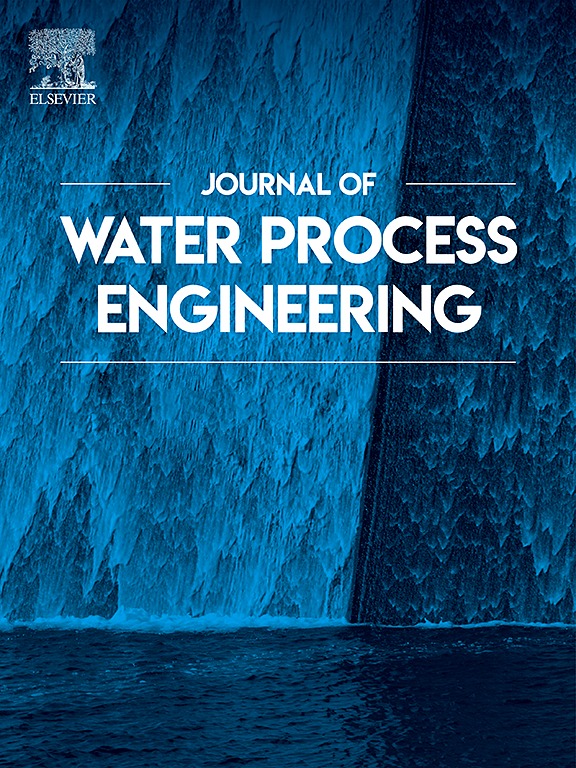Microplastic-induced fouling behavior and mechanisms in algal ultrafiltration process: A focus on microplastic types
IF 6.7
2区 工程技术
Q1 ENGINEERING, CHEMICAL
引用次数: 0
Abstract
In this study, we investigated four commonly found microplastics (MPs) in water—polyvinyl chloride (PVC), polyethylene terephthalate (PET), polypropylene (PP), and polyethylene (PE)—to examine their effects on the removal efficiency and membrane fouling behavior during algae ultrafiltration process. Results indicated that the removal of algae extracellular organic matter (EOM) by ultrafiltration mainly involves in soluble microbial products (SMP) and protein components. The presence of MPs will stimulate the release of algae EOM, thereby reducing the ultrafiltration membrane flux. Compared to membrane fouling caused by raw algae, the degree of membrane fouling increased by 12.6 %, 6.82 %, 10.8 %, and 5.77 % after adding PP, PVC, PE, and PET, respectively. Meanwhile, the EOM removal ratio increased from 28.3 % to 32.7 %, 52.8 %, 50.9 %, and 49.0 % after adding PP, PVC, PE, and PET, respectively. Further analysis revealed that EOM was a key factor affecting the flux and removal efficiency in the algae ultrafiltration process. This was because EOM participated in constructing biofilms, reduced the AB repulsion energy between foulants and ultrafiltration membranes, and formed a relatively compact cake layer, thereby reducing flux and increasing the EOM removal efficiency.

藻超滤过程中微塑料诱导的污染行为及其机制:微塑料类型的研究
在本研究中,我们研究了水中常见的四种微塑料(MPs)——聚氯乙烯(PVC)、聚对苯二甲酸乙二醇酯(PET)、聚丙烯(PP)和聚乙烯(PE)——以研究它们对藻类超滤过程中去除效率和膜污染行为的影响。结果表明,超滤对藻类胞外有机物(EOM)的去除主要涉及可溶性微生物产物(SMP)和蛋白质组分。MPs的存在会刺激藻类EOM的释放,从而降低超滤膜通量。与原藻引起的膜污染相比,添加PP、PVC、PE和PET后,膜污染程度分别提高了12.6%、6.82%、10.8%和5.77%。同时,添加PP、PVC、PE和PET后,EOM去除率分别从28.3%提高到32.7%、52.8%、50.9%和49.0%。进一步分析表明,EOM是影响藻类超滤通量和去除率的关键因素。这是因为EOM参与了生物膜的构建,降低了污染物与超滤膜之间的AB斥力,形成了相对致密的饼层,从而降低了通量,提高了EOM的去除效率。
本文章由计算机程序翻译,如有差异,请以英文原文为准。
求助全文
约1分钟内获得全文
求助全文
来源期刊

Journal of water process engineering
Biochemistry, Genetics and Molecular Biology-Biotechnology
CiteScore
10.70
自引率
8.60%
发文量
846
审稿时长
24 days
期刊介绍:
The Journal of Water Process Engineering aims to publish refereed, high-quality research papers with significant novelty and impact in all areas of the engineering of water and wastewater processing . Papers on advanced and novel treatment processes and technologies are particularly welcome. The Journal considers papers in areas such as nanotechnology and biotechnology applications in water, novel oxidation and separation processes, membrane processes (except those for desalination) , catalytic processes for the removal of water contaminants, sustainable processes, water reuse and recycling, water use and wastewater minimization, integrated/hybrid technology, process modeling of water treatment and novel treatment processes. Submissions on the subject of adsorbents, including standard measurements of adsorption kinetics and equilibrium will only be considered if there is a genuine case for novelty and contribution, for example highly novel, sustainable adsorbents and their use: papers on activated carbon-type materials derived from natural matter, or surfactant-modified clays and related minerals, would not fulfil this criterion. The Journal particularly welcomes contributions involving environmentally, economically and socially sustainable technology for water treatment, including those which are energy-efficient, with minimal or no chemical consumption, and capable of water recycling and reuse that minimizes the direct disposal of wastewater to the aquatic environment. Papers that describe novel ideas for solving issues related to water quality and availability are also welcome, as are those that show the transfer of techniques from other disciplines. The Journal will consider papers dealing with processes for various water matrices including drinking water (except desalination), domestic, urban and industrial wastewaters, in addition to their residues. It is expected that the journal will be of particular relevance to chemical and process engineers working in the field. The Journal welcomes Full Text papers, Short Communications, State-of-the-Art Reviews and Letters to Editors and Case Studies
 求助内容:
求助内容: 应助结果提醒方式:
应助结果提醒方式:


